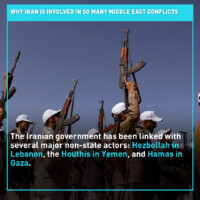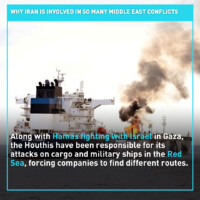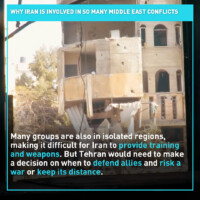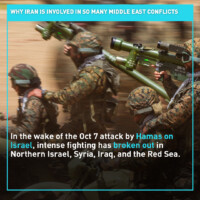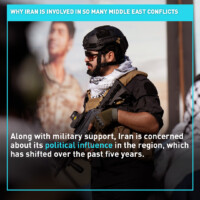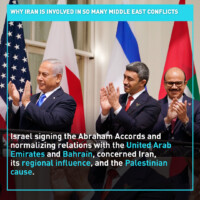Iran has found itself in the middle of rising tensions in the Middle East, influencing the region but also facing major push back from global powers.
Since the start of the Israel-Hamas conflict in Gaza last October, U.S. officials say Iran has become more involved, giving funding to militant groups like Hezbollah, Hamas and the Houthis, an alliance that Tehran calls “the axis of resistance.”
A drone strike on a U.S. military outpost in Jordan on Sunday killed three U.S. soldiers. The Biden Administration blamed an Iranian-backed group and promised a response at a time and a place of its choosing.
Several issues, diplomatic and military, are behind why Iran has been so involved.
Axis of Resistance
According to the New York Times, Iran has invested in building up regional proxy forces to project its military strength, including Hezbollah in Lebanon, the Houthis in Yemen, Shiite militias in Iraq and Hamas in Gaza. These forces launch assaults without them coming from Iranian soil.
However, while fighting Western troops is the goal of the different militants, Tehran only supports them with military and financial power, not ideologically.
Some operate in isolated areas making communications difficult.
Because of that distance, however, experts say Iran can avoid major retaliation from other countries that could destabilize its rule.
The October attack by Hamas in Gaza has led to more violence by these groups across the region, including Israel’s northern front, U.S. bases in Iraq and Syria and ships in the Red Sea.
Regional diplomacy conflict
Iran has tried to open its foreign policy to more nations over the last decade, especially after the U.S. intensified sanctions in 2018.
It has tried to build up relations with Arab neighbors, including normalizing relations with Saudi Arabia in a deal brokered by China.
But neighboring countries have also rebuilt ties with Israel, a concern for Iran.
In 2020, Israel signed the Abraham Accords with the United Arab Emirates and Bahrain to normalize diplomatic relations, while an agreement between Israel and Saudi Arabia was in the works.
According to the Wall Street Journal, Iran’s Quds Force, an arm of the Islamic Revolutionary Guard Corps, wanted to slow normalization efforts.
While American intelligence maintains Iran likely knew about Hamas’ operation, they didn’t have the precise time or scope of the attack.
Iran worked along with former hostile neighbors, Egypt, Saudi Arabia, and the UAE, to implement a brief cease-fire resolution for Gaza.
With political pressure mounting for more action, the U.S. government is deciding what its next options will be.
However, U.S. officials understand a broader conflict is possible if they respond.
 CGTN America
CGTN America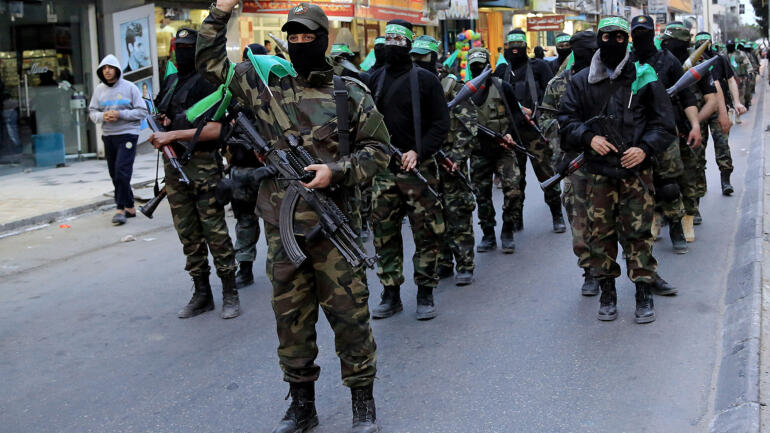 FILE – In this Monday, March 23, 2015, file photo, Palestinian masked militants of Izzedine al-Qassam Brigades, a military wing of Hamas, take part in a parade to mark the 11th anniversary of the Israeli assassination of Hamas spiritual leader Sheikh Ahmad Yassin in Gaza, in the northern Gaza Strip. Egypt’s state news agency is reporting a court has overturned a decision naming Hamas a terrorist organization. The MENA news agency reported Saturday that the Urgent Matters Appeals Court made the decision. They cited a lack of jurisdiction for overturning the early court’s ruling. (AP Photo/Adel Hana, File)
FILE – In this Monday, March 23, 2015, file photo, Palestinian masked militants of Izzedine al-Qassam Brigades, a military wing of Hamas, take part in a parade to mark the 11th anniversary of the Israeli assassination of Hamas spiritual leader Sheikh Ahmad Yassin in Gaza, in the northern Gaza Strip. Egypt’s state news agency is reporting a court has overturned a decision naming Hamas a terrorist organization. The MENA news agency reported Saturday that the Urgent Matters Appeals Court made the decision. They cited a lack of jurisdiction for overturning the early court’s ruling. (AP Photo/Adel Hana, File)

